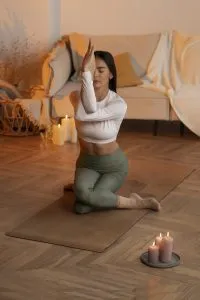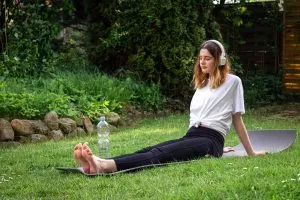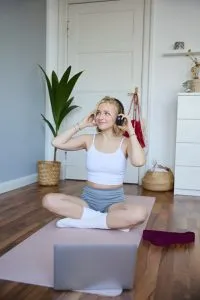Let’s imagine this: It’s 6 AM, your alarm just went off, and you’re already making excuses about why you can’t make it to that morning yoga class. The drive seems too long, the parking will be a nightmare, and honestly, you’re still in your pajamas scrolling through your phone.
Sound familiar?
Here’s the thing – I used to be that person. For years, I had the best intentions about maintaining a consistent yoga practice, but life kept getting in the way. Between work deadlines, family obligations, and the simple logistics of getting to a studio, my yoga mat spent more time collecting dust than supporting my downward dogs.
Everything changed when I decided to create a home yoga space. Not a Pinterest-perfect Instagram setup (although those are lovely), but a real, functional sanctuary where I could roll out of bed and straight onto my mat. The transformation wasn’t just about convenience – it revolutionized my entire relationship with yoga.
If you’ve been struggling to maintain consistency in your practice, dealing with chronic pain that makes studio classes challenging, or simply craving a more intimate connection with your yoga journey, creating your own at-home yoga setup might be the game-changer you’ve been searching for.
In this guide, we’ll explore everything from finding the perfect corner in a cramped apartment to designing a full yoga room that rivals your favorite studio. Whether you’re a complete beginner or a seasoned instructor looking to enhance your home practice, these practical tips will help you create a space that truly serves your needs.

Why Your Home Yoga Space Matters More Than You Think
Let’s be honest – yoga studios are magical places. The energy, the community, the perfectly heated rooms – there’s something undeniably special about practicing alongside others. But here’s what I’ve learned after years of both studio and home practice: your personal yoga sanctuary can be just as transformative, if not more so.
When you create a dedicated space at home, you’re not just setting up a place to exercise. You’re establishing a sacred corner of your world where healing happens on your terms. No rushing to make it to class on time. No worrying about whether you’re keeping up with the person next to you. Just you, your breath, and the space you’ve intentionally crafted for growth.
Research from the International Journal of Yoga shows that consistent home practice can be just as beneficial as studio classes for reducing stress, improving flexibility, and managing chronic pain conditions. The key word here is consistent – and that’s where having a dedicated space becomes crucial.
Think of your home yoga space as your personal reset button. When life gets overwhelming (and let’s face it, when doesn’t it?), you’ll have a place that immediately signals to your nervous system: “It’s time to slow down. It’s time to breathe.”
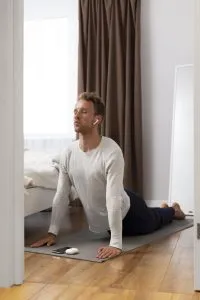
Choosing Your Sacred Space – Location, Location, Location
Finding Your Perfect Spot
You don’t need a mansion to create an amazing home yoga space. I’ve practiced yoga in a 400-square-foot studio apartment, squeezing my mat between the couch and coffee table. I’ve also had the luxury of a dedicated room. The truth? Both served their purpose beautifully when set up with intention.
The secret isn’t about square footage – it’s about choosing a spot that feels right for you.
Here’s what to look for when scouting locations in your home:
Natural light is your best friend. If possible, choose a space near a window. There’s something about morning sunlight streaming across your mat that makes even the most challenging poses feel more approachable. But don’t stress if your options are limited – we’ll talk about lighting solutions later.
Quiet corners work wonders. You’ll want to avoid high-traffic areas where family members (or roommates) might interrupt your flow. That hallway might seem convenient, but trust me, having people walk past during your practice can be more distracting than you’d expect.
Think about your ceiling height. If you love inversions or have dreams of mastering handstands, make sure you have enough vertical space. Nothing kills the yoga vibe quite like bonking your feet on the ceiling mid-pose.

Making Small Spaces Work
Don’t have a dedicated room? Join the club! Some of the most creative yoga room essentials I’ve seen have come from people working with tiny spaces.
Consider these space-saving strategies:
- The bedroom corner approach: Keep one corner of your bedroom clear and use a folding screen or curtain to create visual separation
- The living room transformation: Choose furniture that can easily be moved aside, or invest in pieces that double as storage for your yoga props
- The outdoor option: If weather permits, a deck, patio, or even a section of your yard can become your practice space
Remember, the goal is consistency, not perfection. I know yogis who swear by their kitchen practice (yes, really!) because it’s the only spot in their home that gets morning light.
Creating a Yoga Sanctuary – Design Elements That Actually Matter
Colors That Calm Your Nervous System
When you’re creating a yoga sanctuary, color psychology isn’t just Instagram aesthetics – it’s neuroscience. Certain colors literally affect your brain’s ability to relax and focus.
Stick with nature-inspired, muted tones for your primary palette. Think soft whites, warm beiges, gentle grays, and subtle earth tones. These colors help your nervous system shift into that parasympathetic “rest and digest” mode that makes yoga so healing.
If you’re renting and can’t paint, don’t worry. You can introduce calming colors through:
- A beautiful area rug
- Soft throw pillows or blankets
- Wall hangings or tapestries
- Even your yoga props (choose blocks and straps in calming hues)
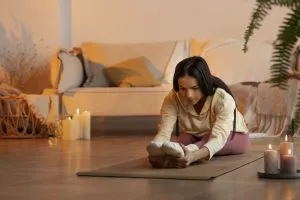
Lighting That Sets the Mood
Here’s where many people get it wrong. They assume any light will do, but lighting can make or break your practice experience.
Natural light during morning practice feels like a gentle wake-up call for your body. If you’re practicing in the evening, warm, dim lighting helps signal to your brain that it’s time to wind down.
Avoid harsh overhead fluorescents at all costs. They’re about as zen as a jackhammer. Instead, try:
- Salt lamps for a warm, amber glow
- String lights for soft, diffused illumination
- Candles (if you’re comfortable with open flames)
- Table lamps with warm-toned bulbs
I keep a small basket of battery-operated candles in my space. They give me that flickering light ambiance without the fire hazard – perfect for deep relaxation poses where I might doze off.
At-Home Yoga Setup: Essential Equipment and Props
The Non-Negotiables
Let’s talk about yoga room essentials that actually make a difference in your practice (not just what looks good on social media).
A quality yoga mat is your foundation – literally. Don’t cheap out here. A good mat provides proper cushioning, grip, and stability. It’s the difference between feeling supported in your poses and constantly adjusting because you’re sliding around.
Look for mats that are at least 6mm thick if you have sensitive knees or practice on hard floors. If you’re doing more dynamic practices, prioritize grip over thickness.
Blocks are game-changers, especially if you’re dealing with tight hips, limited flexibility, or injury recovery. They’re not training wheels – they’re tools that help you practice more safely and effectively. I use blocks in at least half of my poses, and I’ve been practicing for over a decade.
A strap extends your reach without forcing your body into positions it’s not ready for. This is crucial for anyone working through shoulder issues, tight hamstrings, or other mobility challenges.
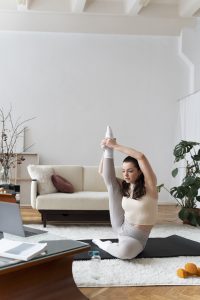
The Nice-to-Haves
Once you’ve got your basics covered, these additions can enhance your practice:
Bolsters and blankets turn your space into a restorative paradise. There’s nothing quite like settling into a supported child’s pose with a soft blanket draped over your back.
A meditation cushion gives you options beyond just asana practice. Some days, sitting quietly might be exactly what you need instead of flowing through poses.
Storage solutions keep your space tidy and inviting. A beautiful basket or small shelf ensures your props are always within reach but not cluttering your practice area.
Smart Storage for Small Spaces
If you’re working with limited space, get creative with storage:
- Wall-mounted mat holders save floor space
- Ottoman storage doubles as seating and prop storage
- Over-the-door organizers can hold blocks, straps, and smaller items
- A decorative ladder can display and store multiple items vertically
Enhancing Your Space: Plants, Scents, and Sacred Objects
Bringing Nature Indoors
Plants aren’t just pretty – they’re actually working hard to improve your practice environment. They purify the air (crucial for pranayama work), add humidity, and create a connection to nature that our nervous systems crave.
Choose low-maintenance options if you’re not naturally green-thumbed:
- Snake plants thrive in low light and need minimal water
- Pothos are nearly indestructible and trail beautifully
- Peace lilies add elegance and actually tell you when they need water by drooping slightly

Scents That Support Your Practice
Aromatherapy isn’t just nice to have – it’s a powerful tool for shifting your mental state. Our olfactory system has a direct line to the limbic brain, which controls emotions and memory.
For energizing morning practices: Try peppermint, citrus, or eucalyptus For calming evening sessions: Lavender, chamomile, or sandalwood work beautifully For focus and clarity: Rosemary or frankincense can help with concentration
Keep it subtle – you want to enhance your breathing, not overwhelm it. A reed diffuser, small essential oil diffuser, or even a few drops on a cloth can be more effective than heavy incense.
Personal Touches That Inspire
This is where your space becomes uniquely yours. What inspires you to practice? What reminds you of your deeper intentions?
Some ideas to consider:
- Photos of teachers, mentors, or loved ones who support your journey
- Crystals or stones that hold meaning for you
- Small statues or figurines that represent peace, strength, or other qualities you’re cultivating
- Quotes or mantras written in beautiful calligraphy
- Items from nature like shells, feathers, or interesting rocks
The key is choosing items that genuinely resonate with you, not what you think a yoga space “should” have.
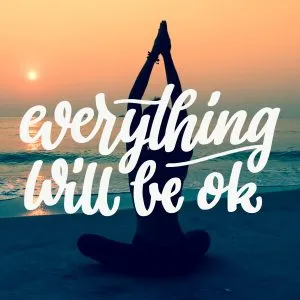
Overcoming Common Challenges
“I Don’t Have Enough Space”
I hear this one a lot, and I get it. But here’s the reality check: you need about as much space as a standard yoga mat takes up – roughly 6 feet by 2 feet. That’s smaller than most people’s dining room tables.
The woman in our Reddit discussion was planning to practice in her hallway, and you know what? She received tons of encouraging advice from people who’d made similar setups work beautifully. Sometimes constraints force us to be more creative and intentional.
“My Family/Roommates Will Interrupt Me”
This is about setting boundaries, not finding the perfect isolated space. Have a conversation with the people you live with about when and where you practice. Most people are respectful once they understand your routine.
Visual cues help too. A closed door, a folding screen, or even just your yoga mat rolled out can signal “practice in progress” to others.
“I Get Distracted at Home”
This is normal and part of the process. Your home has different energy than a studio – there are dishes to wash, emails to check, and a million little tasks calling your name.
Start small. Commit to just 10-15 minutes in your space initially. Turn off your phone (or put it in airplane mode if you’re using it for music). Consider this time as sacred as any appointment you’d make with a doctor or therapist.

Making It Work: Practical Tips for Success
Start Small and Build Gradually
Don’t feel like you need to create the perfect space before you can begin practicing. I started with literally just a mat in my bedroom corner. Over time, I added a block, then a strap, then some plants. The space evolved as my practice deepened.
Begin with the basics: mat, one block, adequate lighting. Practice consistently in this simple setup for a few weeks. Then add elements that would genuinely enhance your experience.
Create Rituals Around Your Space
The power of ritual cannot be overstated. When you consistently perform the same actions before practice, you’re training your brain to shift into “yoga mode.”
Your ritual might include:
- Lighting a candle or turning on your diffuser
- Playing the same opening song or sound bowl
- Taking three deep breaths before stepping onto your mat
- Setting an intention for your practice
These small actions create a bridge between your everyday consciousness and your practice mindset.
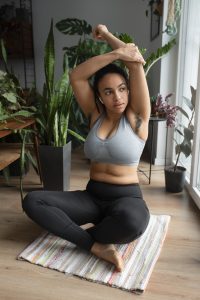
Keep It Clean and Clutter-Free
A cluttered space creates a cluttered mind. Make tidying your practice area part of your post-practice ritual. It doesn’t have to be perfect, but it should feel clear and welcoming when you return.
I keep a small basket nearby for quickly gathering any items that don’t belong in the space. This takes literally 30 seconds but makes a huge difference in how inviting the area feels.
FAQs About Creating Your Home Yoga Space
How much space do I really need for a home yoga space?
You need surprisingly little space – just enough room to fully extend your arms and legs while lying down, plus a little extra for transitional movements. This typically means about 6 feet by 6 feet minimum, though you can make do with less if you modify certain poses. I’ve practiced comfortably in spaces as small as 5 feet by 8 feet.
What are the most essential yoga room essentials for beginners?
Start with these three non-negotiables: a quality yoga mat (at least 6mm thick for comfort), one or two yoga blocks for support and accessibility, and a yoga strap for poses requiring extended reach. Everything else – bolsters, blankets, meditation cushions – can be added gradually as your practice develops and you discover what serves you best.
Can I create an effective yoga sanctuary in a shared living space?
Absolutely! Many successful home practitioners use shared spaces like living rooms or bedrooms. The key is creating visual and energetic boundaries through portable room dividers, curtains, or even just consistent placement of your mat in the same corner. Communicate with housemates about your practice schedule and consider using headphones for music to minimize disruption.
How do I maintain motivation to practice in my home yoga space?
Consistency comes from removing barriers and creating positive associations. Keep your space clean and inviting, lay out your mat the night before, and start with just 10-15 minutes daily rather than ambitious hour-long sessions. Create a simple ritual like lighting a candle or playing the same opening song to signal practice time to your brain.
What’s the best lighting for at-home yoga setup?
Natural light is ideal for morning practices as it helps regulate your circadian rhythm and provides even, soft illumination. For evening practices, use warm, dim lighting like salt lamps, candles, or string lights to help your nervous system shift into relaxation mode. Avoid harsh overhead fluorescents, which can create tension and eye strain during practice.
Your Journey Starts Now
Creating a home yoga space isn’t about having the perfect room or the most expensive props. It’s about claiming a corner of your world where healing, growth, and peace can happen on your terms.
Whether you’re dealing with chronic pain that makes studio classes challenging, juggling a schedule that doesn’t align with class times, or simply craving a more intimate relationship with your practice, your home sanctuary can be exactly what you need.
Remember, the most beautiful yoga space in the world is useless if you don’t show up. Start simple, be consistent, and let your space evolve naturally as your practice deepens.
The woman practicing yoga in her hallway? She’s probably rolling out her mat right now, surrounded by fairy lights and the scent of lavender, proving that magic happens not because of perfect conditions, but because of intention and consistency.
Ready to transform your practice and your space? Start today. Choose your corner, roll out your mat, and take three deep breaths. Your home yoga sanctuary is waiting for you to bring it to life.
What will your first practice in your new space feel like? Close your eyes and imagine it – then make it happen.


